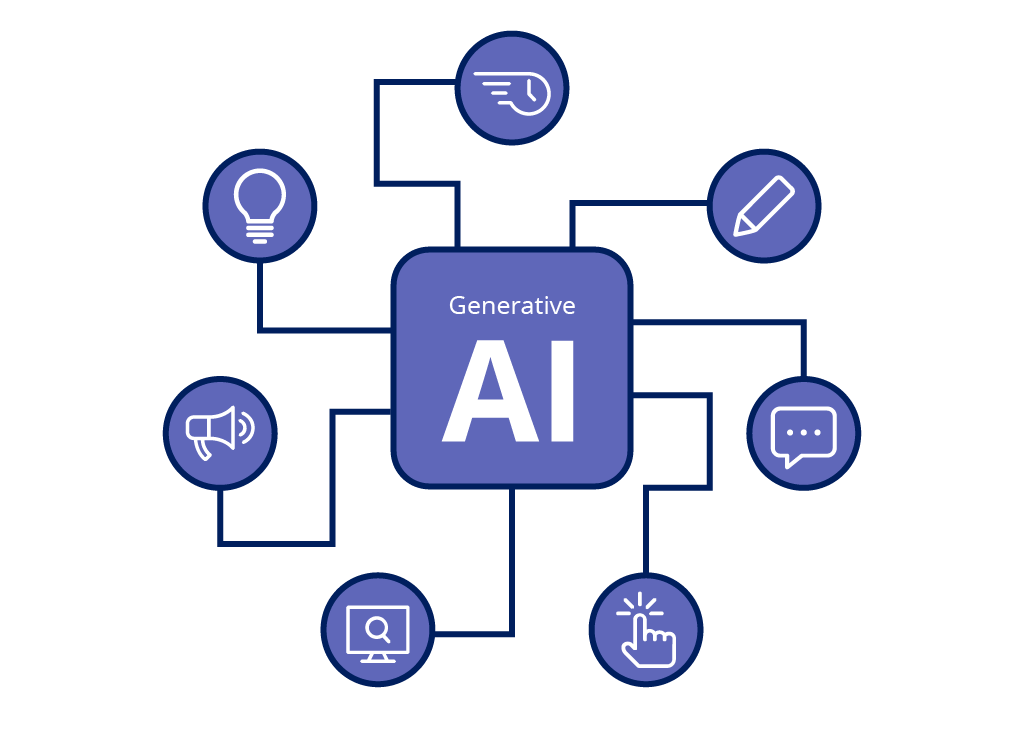
Enterprise generative AI

What is generative AI?
Generative AI is a form of artificial intelligence that leaders across industries are using to generate content: from text and audio, to videos and images, and even code and simulations.
As the technology evolves, it will be able to create more complex outputs like personalized marketing content, custom applications, and even software.

Why is generative AI important for the enterprise?
Across industries, generative AI is automating tasks, enhancing creativity, improving efficiency, and generating realistic content. Examples include medical imaging in healthcare, risk assessment in finance, personalized shopping in retail, and quality control in manufacturing – among many others.
Benefits of generative AI
- Automate repetitive tasks: AI-informed workflows cut out duplicative work so employees can focus on what matters.
- Generate personalized content: Customers expect tailored messaging that speaks to their unique needs. AI makes this possible, at scale.
- Summarize lengthy documents: Get right to the heart of the matter with quick and easy assessment of source materials.
- Keep employees informed: Offer smart pathways to information, processes, and policy to keep everyone up to speed and code-compliant.
- Improves enterprise AI: Generative AI acts as a fuel source for enterprise AI by providing the data and creative spark to train, improve, and innovate with enterprise AI systems.

How does generative AI work?
Unlike machine learning, which trains algorithms to recognize data patterns to drive predictions and decisions, Generative AI is a subset of AI that uses algorithms to create new data or content that’s similar to existing data.

From content creation to workflow optimization, transform your business with the power of AI.

Generative AI vs. predictive AI
Generative AI
- Generative AI creates new content based on patterns and knowledge it has learned during training
- Generative AI is more about creativity and content generation
- Generative AI doesn't require specific input data for prediction and generates content from scratch
Predictive AI
- Predictive AI uses historical data to make forecasts about future events or outcomes
- Predictive AI is more about making informed predictions and recommendations
- Predictive AI relies heavily on past data to make predictions
For further reading on generative AI
5 ways Gen AI transforms work
How GenAI & low code pay off
Why leaders are leveraging AI
Frequently Asked Questions about generative AI
Machine learning is a subset of AI that involves training algorithms to make predictions or decisions based on data. Generative AI, on the other hand, involves using algorithms to generate new data or content that is similar to existing data. While machine learning is focused on making predictions based on existing data, generative AI is focused on creating new data or content. In other words, machine learning is used to recognize patterns in data, while generative AI is used to create new patterns or content based on existing data.
Generative AI is being used across a wide range of industries to automate tasks, enhance creativity, improve efficiency, and generate realistic content. Some of the industries and applications where generative AI is being utilized include: healthcare (for medical imaging), finance (for risk assessment), retail (for personalized shopping), manufacturing (for quality control), and many others.
No, generative AI is not the same as deep learning. Generative AI is a subset of AI that involves using algorithms to generate new data, while deep learning is a subset of machine learning that involves training neural networks to recognize patterns in data. While deep learning can be used to power generative AI models, not all generative AI models use deep learning.
Generative AI has brought about significant advancements in various fields, but it also comes with its own set of advantages and disadvantages. Pros include automating repetitive tasks, generating personalized content, creating concise summaries of lengthy documents, and helping employees get a quick summary of what they need to know. Cons include high implementation and maintenance costs, difficulty ensuring accuracy and avoiding bias, challenges with integration, and the risk of job loss due to automation.
The future of generative AI is promising. As AI models become more sophisticated, generative AI will be able to create more complex and realistic outputs, such as images, videos, and even entire virtual worlds. In the near future, generative AI will likely be used to create personalized content for marketing campaigns, generate custom applications, and even assist with software development. As the technology continues to evolve, it will be important to ensure that generative AI is used in a responsible and ethical manner.

